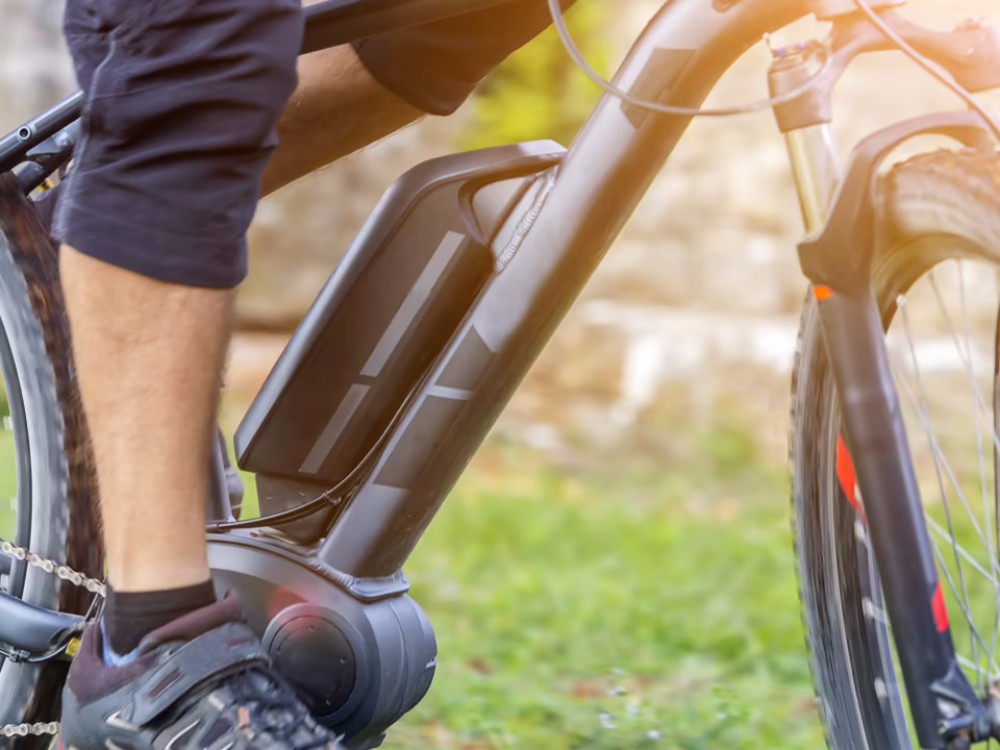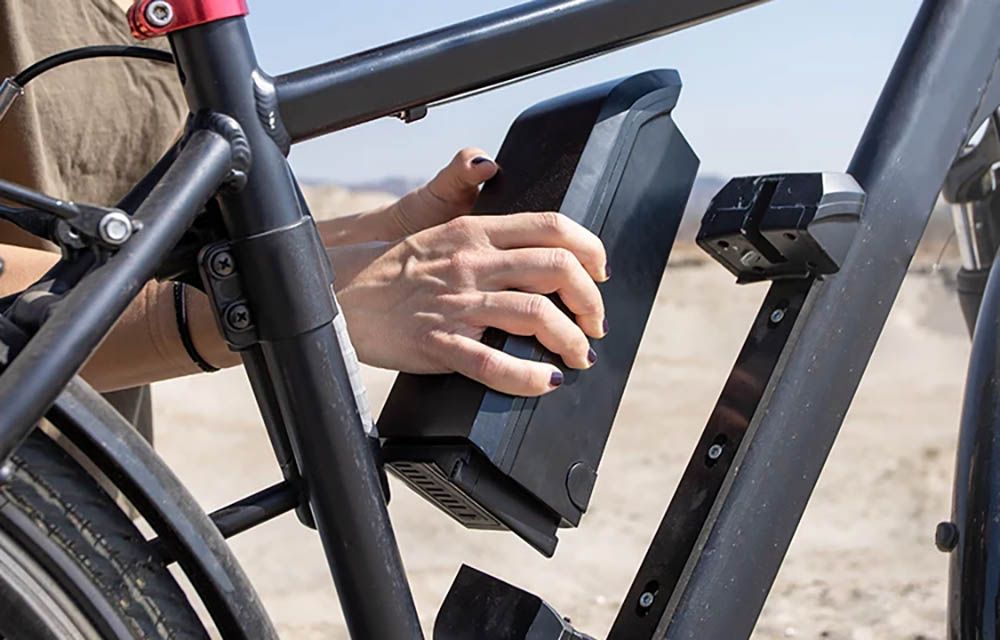How to store e bike battery
Storing your e-bike is vital to ensure the longevity of your e-bike battery. Our guide delves into the do’s and don’ts of storing your e-bike so you can keep riding.
The battery is arguably the most critical component of your e-bike. Correct battery storage is therefore vital to ensure that your battery performs, stays safe and stays in tip-top condition for long periods of time without use. This e-bike battery life guide will help you understand the do’s and don’ts of battery storage, where to store your e-bike battery and discover e-bike battery health tips.
Introduction to e-bike battery storage
 Storing your e-bike battery in a clean, dry and safe location is essential to ensure it is fully functional, maximises battery protection, avoids damage and prevents the risk of fire.
Storing your e-bike battery in a clean, dry and safe location is essential to ensure it is fully functional, maximises battery protection, avoids damage and prevents the risk of fire.
The importance of storing your e-bike battery correctly
The performance of your e-bike battery is vital to the full enjoyment of your prized possession. Keeping your e-bike battery in a dry location at room temperature is therefore vital to ensure optimum health.
Different types of e-bike batteries and their storage needs
Most modern e-bikes use lithium-ion batteries, but achieving optimum performance in battery storage can depend on the type of e-bike battery, and there are many types of e-bike batteries. These include:
Lead-acid batteries: these are the most commonly used on e-bikes worldwide and require the most attention. Also known as sealed valve regulated lead-acid batteries, these batteries draw low current at near freezing temperatures, their lifespan quickly diminishes, and they heat up surrounding wires and other materials at high temperatures. They also self-discharge and must be recharged at least every three months. Therefore, these batteries should be stored in a cool, dry place and recharged once a month for one to three years of continuous use with a cycle life of about 300 cycles.
Nickel-metal hydride batteries: Nickel-metal hydride (NIMH) batteries were popular on early e-bikes, but have similar limitations to lead-acid batteries. They are more durable at high temperatures, don’t work in very cold conditions, and are self-discharging, so ideally need to be recharged monthly. Batteries should last longer, possibly up to 500 rides or ten years.
Lithium-Manganese: these are the most common lithium batteries and can last up to six months (or more) on a charge. It’s best to store them in a cool, dry place with a low risk of fire, but store batteries away from heat sources.
Lithium-ion batteries: most e-bikes now use lithium-ion batteries, like those that power laptops and smartphones. These batteries have a long lifespan and can be ridden thousands of times, and a high-quality battery should last more than five years.
Ideal conditions for storing e-bike batteries
The first thing to consider when storing an e-bike battery for a long period of time is the conditions in which the bike is stored. For example, e-bike batteries should be stored in a location where they don’t collect or can be easily knocked and damaged. Also, avoid storing other items on top of the battery.
Temperature Considerations
The temperature of the location where you store your e-bike battery is critical. The ideal battery storage temperature is 40 to 70 °F at 40 to 50 percent charge, but this can lead to a cold house, so room temperature is fine.
There are two conditions that are particularly damaging: storing below 30F with a low charge, and storing above 80F when the battery is above 80% charged. Keep these batteries away from these conditions and you’ll be fine.
The Importance of Dry, Clean Storage
Safe battery storage practices also include choosing a dry and clean location. Avoid storing batteries near water sources or in areas where leaks can occur. Avoid dirty locations, as dust or dirt can get into the battery and cause damage or loss of performance. Also, keep batteries away from doors and windows, as this may result in moisture exposure.
Battery Certification
Due to the significant increase in fires caused by e-bike batteries, advocacy groups across the U.S., as well as local officials and regulators, are pushing for improved safety certification of batteries, motors and e-bikes.
Note that just because a product is marketed as compliant with UL 2849 or even “UL 2849 certified” doesn’t mean it’s UL safety certified, says Ibrahim Jilani, UL’s global director of consumer technologies. Ibrahim Jilani, UL’s global director of consumer technologies, says that manufacturers must “successfully demonstrate that the requirements of the safety standard are met” before they can obtain UL safety certification. Stay up to date on the latest products certified to UL 2849. We recommend that you ask for proof of certification from the brand from which you purchased your e-bike or battery.
Best Practices for Maintaining and Charging E-Bike Batteries
Proper charging and regular maintenance of your e-bike battery will help keep it safe and extend its life. Considerations here include:
Charging cycles and their impact on battery health
It can be tempting to charge your e-bike battery before you go to bed and keep it maxed out all night. However, overcharging an e-bike battery reduces its long-term capacity, carries the risk of the battery melting or overheating, and affects its long-term performance.
Fully discharging a battery to zero also reduces its capacity and affects its ability to hold a charge over the long term, so the e-bike battery charging trick is to put it somewhere in the middle. Another important consideration is to only use the correct charger, even if similar chargers appear to be compatible, as this can damage the e-bike battery.

Tips for Maintaining Battery Terminals and Connections
You may be thinking, “Geez! That’s a lot already.” Well, it doesn’t have to be. Keep in mind the following quick tips on battery terminal and connection maintenance:
Regularly checking connections, cables, and terminals can also help extend the life of your e-bike battery.
Keeping the battery clean, even with a damp cloth, is a good start, but also lubricate the terminals and connections regularly.
Avoid using hoses or high-pressure jets when cleaning, as this may damage the battery or connections.
Test and monitor battery health regularly
If you plan to store your bike for a long period of time, for example over the winter, try to avoid locking it up and forgetting about it. If the battery is left uncharged for a few months, this may lead to a drop in performance when it is used again.
For example, we recommend: “If you don’t ride during the winter months, it’s important to store your battery inside the vehicle and keep it properly charged. Keep the charge level at 50% when storing.”
Precautions for storing e-bike batteries
Before storing your e-bike battery, you should consider some additional battery storage tips. For example:
Avoid potential fire hazards
It goes without saying that your e-bike battery should not be stored anywhere near a potential fire hazard. Lithium-ion batteries can be dangerous, so avoid heat sources and anything flammable.
Safe handling and transport of e-bike batteries
E-bike batteries can be unstable and dangerous if not handled properly. Lithium-ion batteries use flammable lithium powder that explodes when they come into contact with oxygen, which means there is a high risk of fire if you try to switch it on. Therefore, if your battery is faulty, avoid opening it at all costs and take it to a professional rather than trying to check or repair it yourself.
Disposing of Damaged or Old Batteries
Modern e-bike batteries manufactured by UL safety certified companies are generally safe and of very high quality. However, all batteries deteriorate over time and the most common causes of failure are incorrect connection or loss of capacity over time after repeated use.
When your e-bike batteries fail, it’s vital to know what to do with them. You can have them refurbished or recycled by experts or take them to an official battery recycling centre. However, never dispose of your battery in the rubbish or recycling bin as this is dangerous and potentially illegal.
An excellent resource for the safe disposal of e-bike batteries is the National E-Bike Battery Recycling Scheme, which has over 50 brands participating and more than 1,800 recycling points across the country.
Fill in the information below now and let our well-designed e-bikes and quality outdoor accessories take you on a journey to explore nature and unleash your passion for unlimited adventure!
 Shuangye ebike
Shuangye ebike
